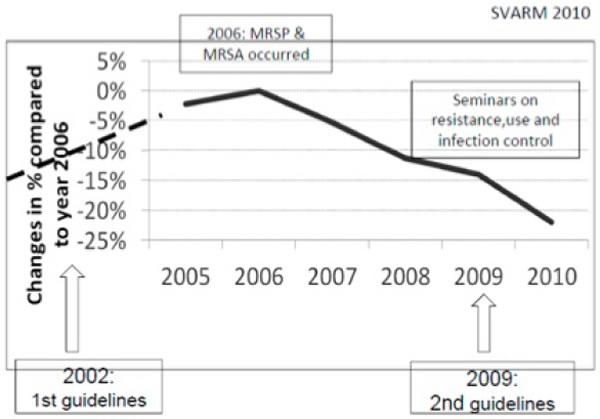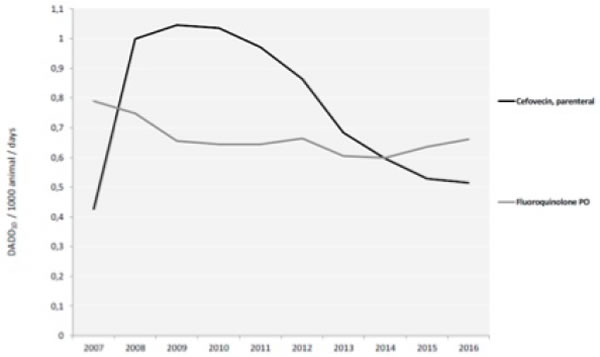L.R. Jessen
Department of Veterinary Clinical Sciences, University of Copenhagen, Denmark; European Study Group of Veterinary Microbiology
Antibiotic usage has long been recognized as the main driver for the selection of antibiotic-resistant pathogens. Strategies to enhance rational antibiotic prescribing are therefore of uppermost importance in the combat against antibiotic resistance. Guidelines on rational antibiotic use aim at improving patient outcome while minimizing the selection for antimicrobial resistance, and are considered a cornerstone in antibiotic stewardship. Such guidelines are written as clinical practice guidelines (CPG) indicating diagnostic criteria for - and recommended therapy (drug, dose, duration) of - infectious diseases of bacterial origin. When implemented at practice or hospital level, CPGs hold a huge potential to impact prescribing habits of veterinary clinicians and promote prudent use of antibiotics.1
The effect of national CPGs is much more difficult to assess. In Sweden, national antibiotic use guidelines for companion animals2 were first published in 2002 and later revised in 2009 by the Swedish Small Animal Association. In 2010, national guidelines were launched by the Swedish Medical Agencies, and from January 2014 Sweden implemented legal measures to restrict the use of third/fourth-generation cephalosporins and fluoroquinolones.
The first set of guidelines did not receive much attention and had no apparent effect on consumption data. From 2006 the overall consumption of antibiotics started decreasing (Figure 1), and by 2015 the sale of antibiotics for oral use in dogs had dropped by 53% as compared to 2006.3 In a survey conducted in 2012 on antibiotic use and prescribing habits among veterinary practitioners from seven European countries, Swedish small animal practitioners reported a very low use of critically important antibiotics4 and, as the sole country, indicated antibiotic guidelines as the most important factor influencing their prescription habits5.
| Figure 1. Companion animal AB consumption from 2005–2010, Sweden | 
Courtesy of Dr. Ulrika Grønlund |
|
| |
In Denmark the first national antibiotic use guidelines for companion animals were published in late 20126 and are due for revision in 2017. National data indicate a 10% reduction in the total antimicrobial consumption for companion animals from 2012 to 2016 with the lowest consumption being in 2015 (-14%).7 With regard to critical and/or broad-spectrum drugs, a marked reduction in the use of third/fourth-generation cephalosporins (cefovecin) has been observed, whereas fluoroquinolone consumption remained at a steady level except for a minor transitory decrease in 2013 (Figure 2). A minor transitory decrease was also observed for amoxicillin clavulanate in 2013 followed by a steady increase from 2014.
| Figure 2. Consumption of critical antibiotics for companion animals in Denmark 2007–2016 | 
Courtesy of Dr. Vibeke Frøkjær |
|
| |
The impact of the CPG on antibiotic consumption is difficult to separate from other events, and the overall experience from both countries is that publishing guidelines alone has limited impact. In Sweden, the guidelines lived a life in silence until the first MRSP isolates in companion animals were isolated in 2006. This MRSP/MRSA outbreak created awareness on antibiotic resistance among companion animal practitioners, and led to numerous talks around the country on prudent AB use and infection control. Talks were mainly organized by the Swedish National Veterinary Institute (SVA) in response to demands from clinicians. Between 2006 and 2016 Sweden moved from being the highest to the lowest antibiotic-consuming country in Scandinavia. It is worth noticing that the MRSP/MRSA outbreak made the implementation of guidelines and infection control a bottom-up process in Sweden, which may partly explain the success of the Swedish antibiotic policy.
In contrast to Sweden, there appeared to be a small, more immediate but less sustained effect of the Danish guidelines. The initial effect is probably explained by the activities around the time of the launching including inauguration of the guidelines at the national veterinary conference, distribution of the hard copy booklet by mail to all members of the Danish Small Animal Veterinary Association (DSAVA) and a campaign on prudent antibiotic use in skin and gastrointestinal infections. The effect of campaigning activities was also apparent in a recent survey among Danish practitioners showing a high degree of adherence to guidelines for skin diseases.8 The current challenge in Denmark is to re-create awareness of antibiotic resistance, and to promote the role of infection control and prudent antimicrobial use. The effort must be continuous to ensure a sustained response.
Future Directions
The experience from Sweden and Denmark shows that national guidelines carry a real potential for promoting rational antibiotic use if supported by proper dissemination strategy and campaign activities.
The emergence of antibiotic-resistant bacteria in companion animals in Europe calls for action throughout the region. The ESCMID Study Group of Veterinary Microbiology (ESGVM) has therefore launched an initiative on the development of European antibiotic use guidelines in companion animals. European guidelines may support national and local guideline makers when writing recommendations on diagnostic procedures and therapy of common bacterial infections.
Acknowledgement
Oscar Nilsson from SVA and Ulrika Grønlund from Anicura Group for helping out with the Swedish data and Vibeke Frøkjær Jensen from the Danish Technological University (DTU) for assisting with the Danish data.
References
1. Weese JS. Investigation of antimicrobial use and the impact of antimicrobial use guidelines in a small animal veterinary teaching hospital: 1995–2004. Journal of the American Veterinary Medical Association. 2006;228(4):553–8.
2. Veterinärförbunds. Antibiotikapolicy för Hund - och Kattsjukvård. Sweden: SVS; 2009. Available from: www.sva.se/upload/Redesign2011/Pdf/antibiotika/antibiotikapolicy_2009.pdf.
3. Swedres/Swarm. Consumption of antibiotics and occurrence of antibiotic resistance in Sweden. Solna/Uppsala. 2015.
4. De Briyne N, Atkinson J, Pokludova L, Borriello SP. Antibiotics used most commonly to treat animals in Europe. The Veterinary Record. 2014;175(13):325.
5. De Briyne N, Atkinson J, Pokludova L, Borriello SP, Price S. Factors influencing antibiotic prescribing habits and use of sensitivity testing amongst veterinarians in Europe. The Veterinary Record. 2013;173(19):475.
6. Jessen LR, Damborg P, Spohr A, Schjøth B, Wiinberg B, Houser G, et al. Antibiotikavejledning til familiedyr: Den Danske Dyrlægeforenings Sektion for Hund, Kat & Smådyr, SvHKS, Emdrupvej 28A, 2100 København Ø ; 2012.
7. DANMAP. Use of antimicrobial agents and occurrence of antimicrobial resistance in bacteria from food animals, food and humans in Denmark. 2016.
8. Lilja ZL, Sørensen TM, Kristensen M, Hald T, Damborg P, Jessen LR. Danske Dyrlægers brug af Antibiotikavejledning til Familiedyr - en spørgeskema undersøgelse. Dansk Veterinær Tidsskrift. 2016;99(November):19–25.